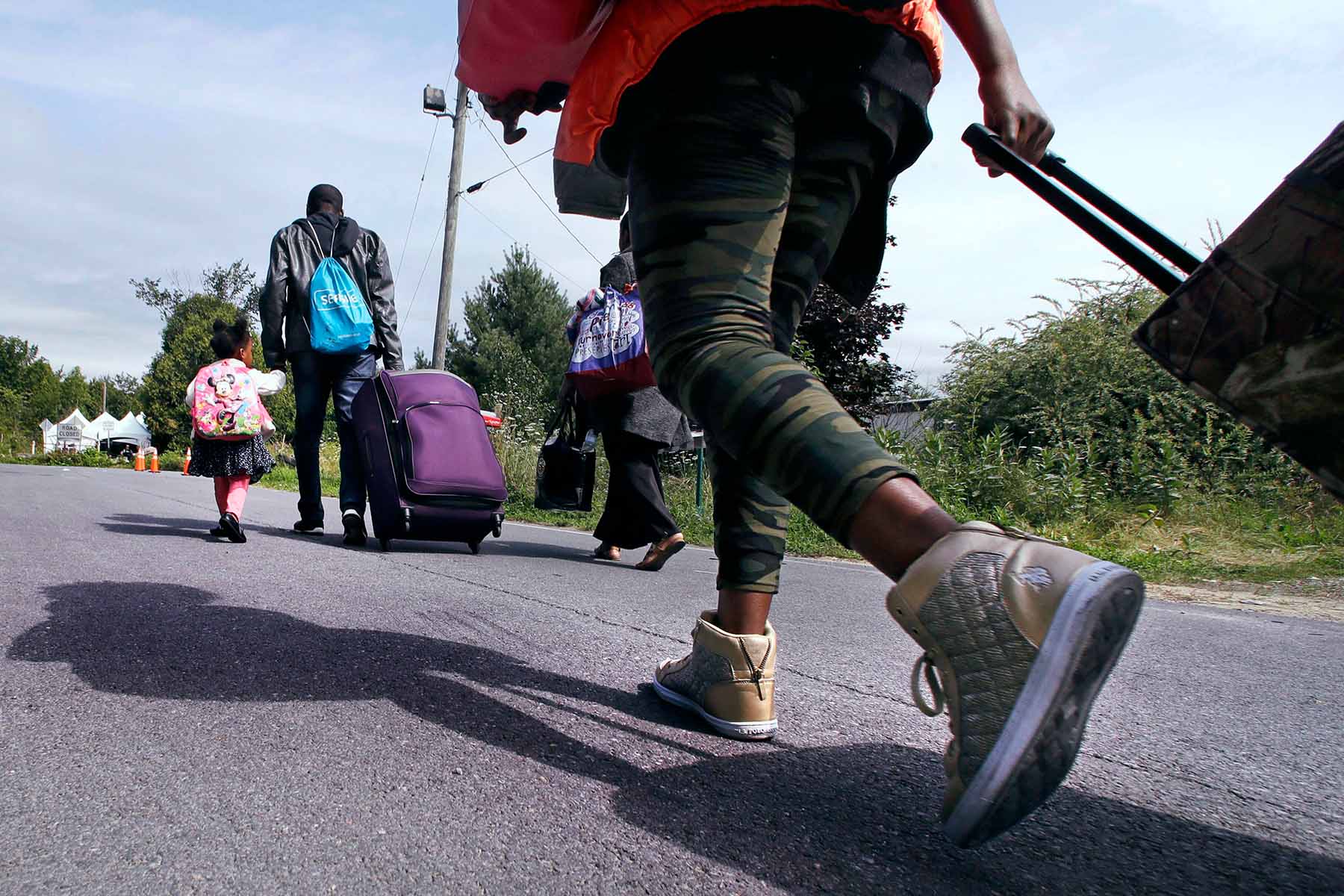Before Roxham Road became the last hope for asylum seekers looking to start a new life, before it became a political lightning rod for Prime Minister Justin Trudeau, before it was both a logistical problem and bargaining chip for Quebec premier François Legault, it was nothing more than a dirt road between Hemmingford, Quebec, and Plattsburgh, New York—a small blip on the 8,891 kilometres of shared border between Canada and the US. Before 2017, most people hadn’t heard of Roxham Road.
Then US president Donald Trump would change all that. His decision to drastically reduce the number of refugees the US would accept in 2017, from 110,000 to 50,000, would have a major impact on the increase of irregular migrants entering Canada (“irregular” meaning they bypassed official ports of entry). Trump’s rhetoric against foreigners, migrants, Muslims, and refugees prompted many to try their luck in Canada. There were 2,464 irregular entries apprehended by the RCMP in Quebec, Manitoba, and British Columbia in all of 2016. By the end of 2017, that number would climb to 20,593.
Quebec alone would see 18,836 people cross through Roxham Road that year. Roxham Road was a loophole in the Safe Third Country Agreement between the US and Canada. Established in 2004, the STCA requires asylum seekers to request protection in the first safe country they arrive in. Those entering Canada from the US away from official points, however, could claim asylum, leading many to use routes like Roxham Road. By March 2023—when Roxham Road was closed for good—a total of 95,610 irregular asylum seekers had used it to cross into the country. What started as a nondescript rural road had transformed into a tent village and compound, complete with trailers to process people.
Despite the rapid changes and the temporary disruption to Canada’s refugee processing system, the situation was handled better than often thought, say migration experts. “Compared to what’s going on in the Mexico–US border or the eastern borders of Europe, it was still a very manageable situation here,” says Stephan Reichhold, who, as director of the Coalition of Organizations Serving Refugees and Immigrants in Quebec, is responsible for coordinating over 150 community organizations. “In Quebec, we have a very good network of agencies and organizations who are quite well organized in dealing with asylum seekers. The big issue was the concentration in Montreal.”
Nevertheless, the constant influx of migrants would slowly lead to growing frustrations—especially in Quebec, where the impact of arrivals was felt the most as they continued to strain social services and depleted resources—and increased calls to close the border. “Politicians were very afraid of public opinion and this overall perception that Canada was not capable of controlling its own borders,” says Reichhold.
Canada’s welcome mat started to fray as administrative backlogs forced claimants to wait months and sometimes years to be processed. In June of 2022, the federal government quietly started transferring small groups of asylum claimants who had entered Quebec through Roxham Road to other provinces to alleviate some of the pressure on the province.
Trudeau’s goodwill began to wane as Roxham Road became a political lightning rod for his administration and poll after poll showed Quebecers wanted Roxham closed. “Things pivoted at that point,” says Mireille Paquet, who holds the Concordia University research chair on the politics of immigration, “and everyone was trying to find a solution that would involve closing Roxham Road.”
As a migration expert, Paquet says it was difficult hearing people discuss Roxham Road and assume there are simple fixes. “People are going to show up whatever we do,” she says. “If you close Roxham Road, people are just going to cross somewhere else. We’ve seen that happen. And I think people in Ottawa were very aware of that too.”
In February 2023, Legault, in a letter published in the Globe and Mail, warned that the situation raised several humanitarian considerations, as “it is becoming increasingly difficult to receive asylum seekers with dignity.” Legault wasn’t wrong. Community organizations and an army of volunteers on the ground were working overtime to deal with a deficient reception system and dwindling resources. “Our services are stretched to the maximum,” Jean-Sébastien Patrice, general manager of Cafeteria MultiCaf, a community food resource that serves Côte-des-Neiges, was quoted as saying. “We are at 400% of our capacity, without substantial funding to meet emerging needs.”
But Legault wasn’t right either. The provincial government was also reluctant to increase funding to the organizations that needed it the most. “We managed to get a bit of money, some urgent funds, this past January, but it was a drop in the bucket,” says Reichhold.
Taking his cue from the Quebec premier’s letter, federal Conservative leader Pierre Poilievre demanded that Trudeau close the border within thirty days, without offering any explanation as to how that would be done—a request Trudeau dismissed as simplistic and futile, considering the kilometres of undefended border between the two friendly countries and the fact that a bilateral treaty must be signed by both parties. Instead, the Canadian government focused on diplomatic solutions, quietly trying to renegotiate the STCA with a US that had far bigger problems on its southern border.
On March 23, 2023, Trudeau and US president Joe Biden jointly announced that, after many stalled talks, the two governments had reached a deal. This agreement expanded the STCA and allowed Ottawa to close the Roxham Road irregular crossing at the Canada–US border by closing the loophole in the agreement that had prevented Canadian border guards from turning back irregular asylum seekers. With very few exceptions, no one can now request asylum in Canada if they’re arriving by land from the US, whether they present themselves at official or irregular Canadian ports of entry. The deal took effect at midnight the very next day, to avoid a possible surge of claimants rushing to cross into Canada.
Legault referred to the agreement as “a beautiful victory for Quebec.” Migration experts felt otherwise. “I would have preferred to have seen the agreement suspended,” says Paquet. “But I don’t think the Canadian public is ready for what that means.”
While asylum rights advocates and Amnesty International have long insisted the STCA should be terminated because it incentivizes irregular crossings and human smugglers, and because it’s based on the debatable premise that the US is a safe country for asylum seekers, the bilateral agreement has been defended by both governments. They insist that it allows for the orderly and fair handling of refugees.
Despite her disappointment, Paquet says that, at least for a certain period, people were able to enter Canada and go through due process. “It’s not perfect,” she says, “but it’s better than what Australia is doing, sending them to an island, or Europe, sending them to Libya. I’m not okay with what the government did, but I think it’s important to highlight.”
Many asylum seekers would agree. Despite the imperfect conditions, many say they were greeted at the border with kindness. In June of 2023, I moderated a panel for the Samuel Centre for Social Connectedness, which brought together asylum seekers, nonprofits working with refugees, and volunteers at the Roxham Road border. Ali, a physician who had fled Sudan and crossed Roxham Road at night along with her daughter, described the immense gratitude she felt for Canadian border guards reassuring her that she was now in a safe country. Coming from a place, she said, where military and border police were not people you went to for help, she repeated how thankful she was for the humane way she had been greeted at Roxham Road.
But those who walked weeks and months to reach the Canadian border only to now find it closed will certainly feel otherwise. Immigration lawyer Guillaume Cliche-Rivard, who has represented many asylum seekers and people with precarious status, says that “a lot of refugee claimants [are] now stuck in the US with no safe or secure way of requesting asylum over there.” Those working with volunteer associations on the other side of the US border confirm this to be true, as the sudden closing has left many who spent months on the way to Roxham Road now stranded, penniless, and isolated in nearby rural towns, with no resources at all.
Paquet’s main disappointment is that many alternative paths to resettlement were not explored. “We have people show up at the border because there’s no way for them to apply while in the US,” she says. One way would have been to normalize part of that process so that people who want to come would be able to do the paperwork from there, but that’s difficult to implement, she explains, because a lot of people in the US are without status. “If they show up and apply for asylum, they risk deportation.”
Amnesty International says the updated agreement creates an unfair situation for people seeking asylum, and migration experts all seem to agree that closing Roxham Road will lead to more humanitarian catastrophes. That’s because the dangers for those attempting to cross have now increased. “If you look at Roxham Road until now,” says Luna Vives, associate professor in the department of geography at Université de Montréal, “there were no smugglers and human traffickers because anyone who could make it to the border could cross into Canada. If you close the border, you don’t stop that movement, you just force people to pay smugglers.” She says that by closing Roxham Road, the government is in fact creating the conditions for the industry.
Vives, whose research focuses on migration policy, points to what’s been happening at the US–Mexico border since the 1950s as a cautionary tale. “You have families who see no other option but to resort to ‘coyotes,’” she says:
It’s a business. Every month we hear about children—sometimes infants—being abandoned along the border because they need a diaper change, or because they’re too loud or too slow. It’s not a matter of the government maybe endangering people’s lives. With this kind of policy, they are endangering people’s lives. Those at the receiving end are going to be disproportionately people already in situations of risk.
While Cliche-Rivard says he can’t guess the future, he, too, worries that closing Roxham Road will amplify smugglers’ power. “Many of these people crossed many, many borders,” he says, “so what’s going to stop them when they’re at risk?” He warns that when your family is going to be deported and you’re sure you’re going to be killed, when you’re desperate, you don’t always make the best decisions. “It’s often not even a decision, it’s the only choice you have.”
What’s been observed since Roxham Road was closed only lends credence to migration experts’ warnings that the closure of border crossings was never a real solution. Regular arrivals at the airport have increased in the months immediately following the March announcement. While interceptions at the Roxham Road land border plummeted from 4,087 in March 2023 to sixty-nine in April, the number of asylum applications at airports tripled, “when comparing April 2022 to April 2023, from 565 to 1490,” reveals a La Presse article. “Result: the number of new asylum seekers arriving in the country during the first four months of the year, i.e., 24,395, is roughly the same as last year.”
A Radio-Canada investigation in August of 2023 confirmed that, four months after Roxham Road closed, not much had changed. “In June, the number of asylum seekers approached the 11,000 mark across Canada,” reads the article. “A figure that even exceeds the levels observed at the start of the year, before the change in the rules at the border.”
So, while the perception of being inundated by asylum seekers had been eliminated with the closure of Roxham Road, the reality in terms of numbers is more or less the same. People keep coming. Migration doesn’t stop. “The ideal solution,” says Vives, “would be to repeal the STCA altogether, but since that’s unlikely, the next best option would be to make it possible for more people to be eligible to stay. To expand the profiles that can present themselves at the border and apply for asylum.”
Vives says another step in the right direction would be to make the system that evaluates claimants more efficient so people don’t have to wait so long. The government should decide early on whether they’re eligible or not, she says, and if they are, help them make their way socially and economically and in the workplace. “That’s the bare minimum,” Vives says. “We need a functioning Immigration and Refugee Board, a determination system, and a border that honours Canada’s obligation to be a haven for people whose lives are at risk.”
Until recently, says Paquet, Canadians were very protected from what was happening globally. “Suddenly,” she says, “we have to adjust. And there’s no going back.” While she’s quick to point to information asymmetry as contributing to unnecessary fears about those entering via Roxham Road, Paquet is empathetic to the average person’s experience of discomfort. “We’re dealing with something that is new for us as a society,” she says. The migration researcher says it’s important to remain as empathetic as possible toward people confronted by all this for the first time who may find it frightening. “Part of the problem is that we minimize it, but for many people, it’s a lot . . . they don’t understand the system, they don’t know what’s happening, they don’t know who these people are.”
Across the border, Janet McFertridge, mayor of the village of Champlain, a retired schoolteacher, and a volunteer with Plattsburgh Cares, has spent the past six years welcoming and helping asylum seekers near Roxham Road where she lives. She’s now seeing the consequences of a closed border, as many migrants find themselves stranded with nowhere to go and no resources at all. A big part of helping them is decreasing suspicion toward them and increasing people’s willingness to see their humanity. “Rural America is not always the beacon of welcomeness,” she says. “I believe this is due to a lack of interaction with asylum seekers and an unfounded fear of them.” Sometimes the best tactic is to tackle the misconceptions directly. McFertridge refers to this as “being deliberately inclusive” with kindness and sensitivity:
It’s hard to hate someone up close. It’s difficult to walk away from a hungry toddler. It’s difficult to walk away from a mother sobbing as she hugs her children tightly. It is difficult to walk away from a father who says he only wants to work to support his family and now he has failed.
Finding common ground and tactics that educate the public and ease their fears while also helping newcomers integrate is what those close to the issue of migration hope for. “When I meet people who tell me that they heard somewhere that migration increases crime, which is factually incorrect,” says Paquet, “and research has demonstrated that it’s not true, I want to find a place where I don’t tell someone they’re stupid but have empathy for their fears.”
Reichhold reminds me that about 40,000 asylum seekers came through Roxham Road back in 2016. “They are now our neighbours, they integrated, they’re working. Most of them are permanent residents. Five years later, no one cares about them. They were never a ‘crisis.’”
Excerpted from Seeking Asylum: Building a Shareable World by Toula Drimonis. Published by Linda Leith Publishing. Copyright © 2024. Reproduced by arrangement with the publisher. All rights reserved.





